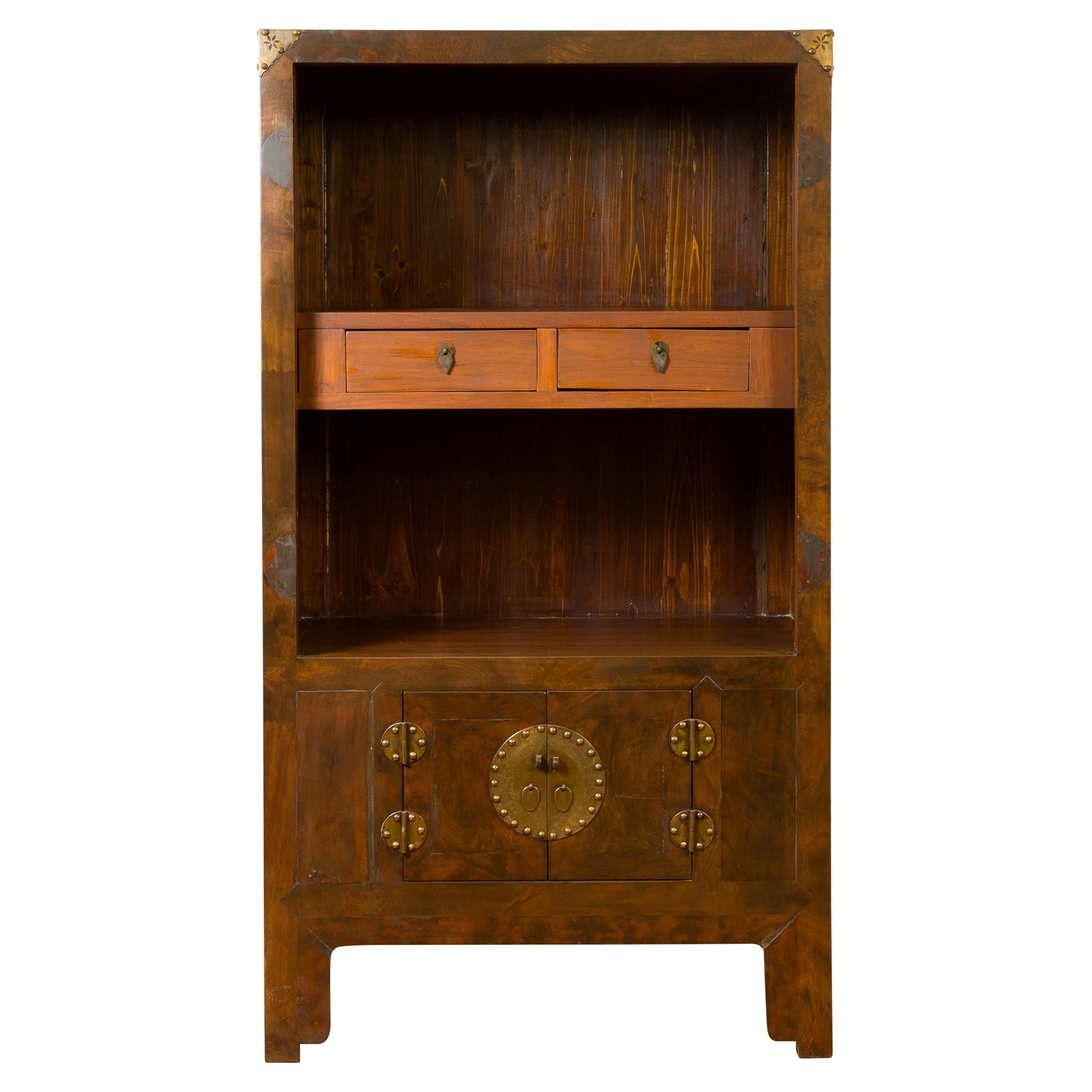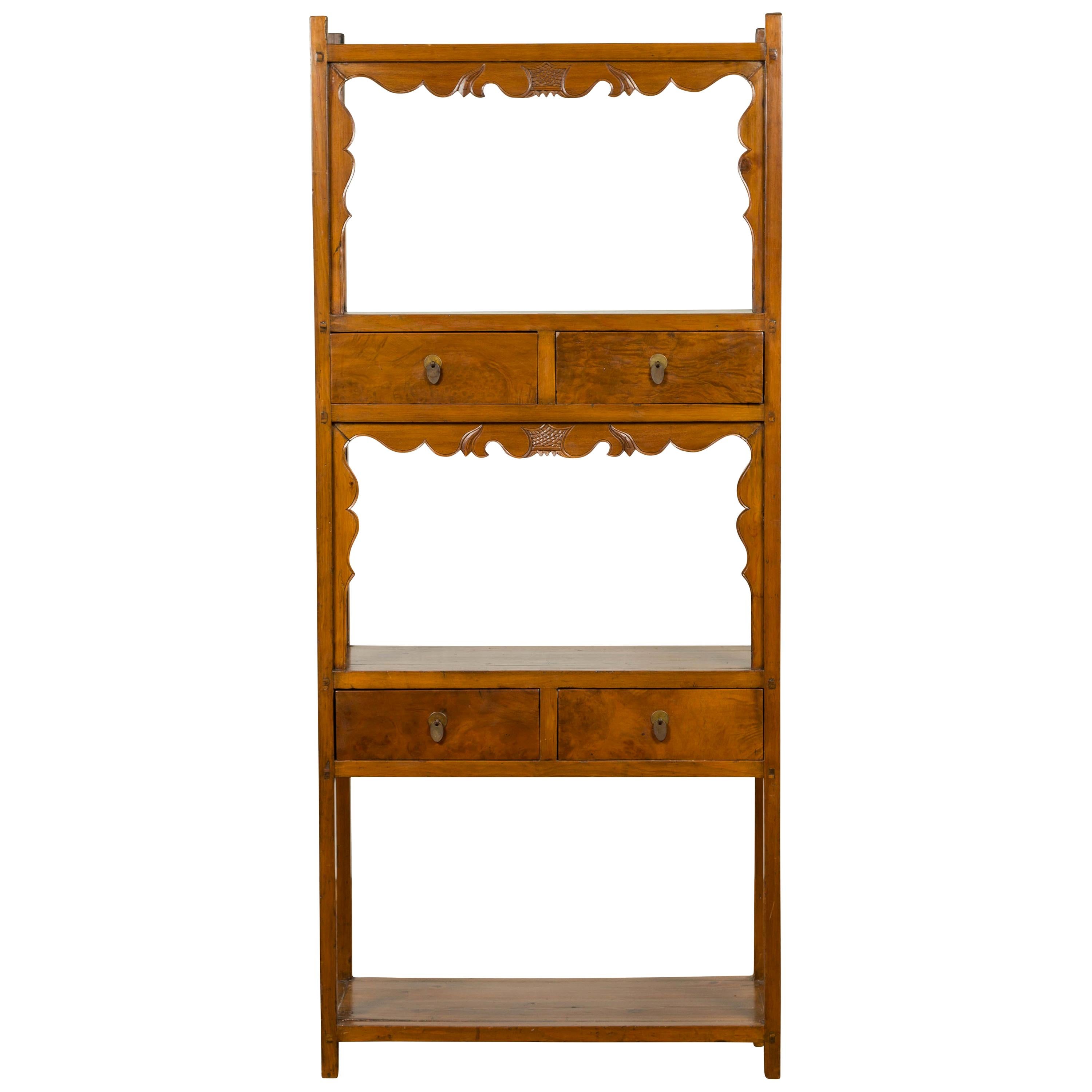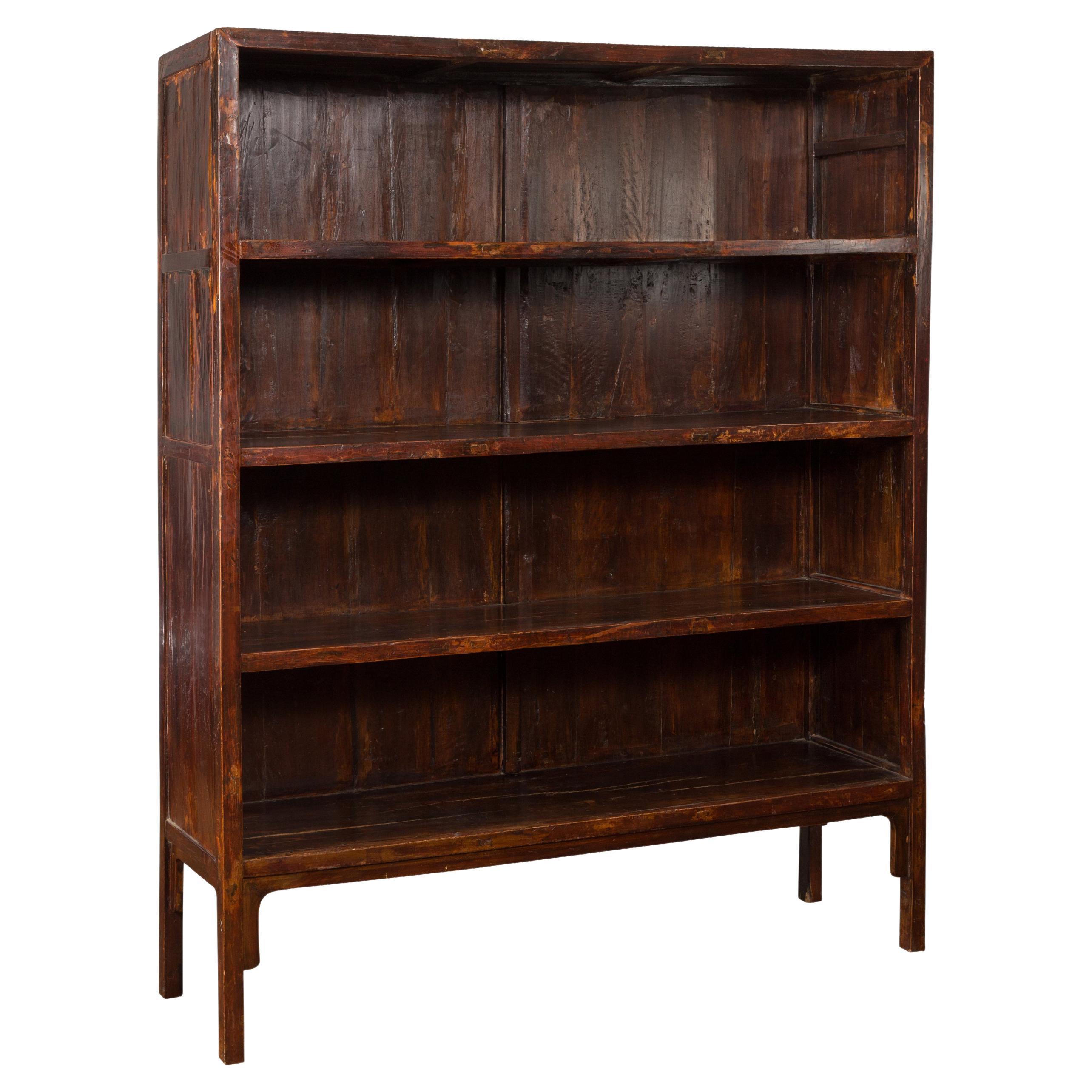Items Similar to 19th Century SE Asian Highly Carved Wooden and Gilded Floor/Wall Cabinet
Want more images or videos?
Request additional images or videos from the seller
1 of 20
19th Century SE Asian Highly Carved Wooden and Gilded Floor/Wall Cabinet
About the Item
PRESENTING an EXCEPTIONAL AND RARE 19C SE Asian Highly Carved Wooden and Gilded Floor or Wall Case or cabinet featuring Hindu Gods.
OUTSTANDING and VERY RARE!
Mid 19th Century, circa 1850 and probably Cambodian, Thai or Burmese, carved rosewood floor or wall shelf. We think it is Cambodian.
Can be hung on the wall using brackets or used on the floor, as depicted in the photos.
Incredibly carved wood. The front has hand-carved statues depicting the Hindu Gods with hand applied gold gilding has been added to highlight the carving and facial features of the Deities.
The piece has 12 open shelves each one fronted on either side by a carved depiction of a Hindu God.
The central 'shrine' is a 2 door press that opens to reveal two further shelves.
The handles to the 'shrine' are likewise made of carved figures of Hindu Gods.
There is a large drawer to the central base with a wonderful carving of a female God reclining.
The base section is flanked on either side by a pair of glorious 'Foo Dogs' or 'dragons'.
The back and side walls of the entire piece consist of hand-carved fretwork to allow back light (Clever use of LED strips looks great with this piece).
The Central compartment is designed like a central shrine.
Has to be seen to be truly appreciated. a one of a kind piece of art.
Timeless, Rare and HIGHLY DESIRABLE!
ONCE IN A LIFETIME OPPORTUNITY!
Provenance: Bought at Auction in UK
Condition: Very good considering its age and fretwork carving. Some very minor losses and repair work to the right central tabernacle door. Loss of one small panel on extreme bottom left. The gilt work has been regilded with 24 kt gold leaf, to make it look even more impressive.
- Dimensions:Height: 32 in (81.28 cm)Width: 73 in (185.42 cm)Depth: 10.5 in (26.67 cm)
- Style:Folk Art (Of the Period)
- Materials and Techniques:
- Place of Origin:
- Period:
- Date of Manufacture:1850
- Condition:Refinished. Repaired: Support brackets and repairs to inside of central tabernacle door. Wear consistent with age and use. Minor losses. Minor structural damages. Minor fading. Very good considering its age and fret carving. Some very minor losses and repair work to the right tabernacle door. Loss of one small panel on extreme bottom left. The gilt work has been redone with 22 kt gold leaf, to make it even more impressive.
- Seller Location:Dallas, TX
- Reference Number:1stDibs: LU3978119150592
About the Seller
4.9
Platinum Seller
These expertly vetted sellers are 1stDibs' most experienced sellers and are rated highest by our customers.
Established in 2015
1stDibs seller since 2018
349 sales on 1stDibs
Typical response time: <1 hour
- ShippingRetrieving quote...Ships From: Dallas, TX
- Return PolicyA return for this item may be initiated within 7 days of delivery.
More From This SellerView All
- 19th Century French Provincial Highly Carved Oak Hunt BookcaseLocated in Dallas, TXPRESENTING AN ABSOLUTELY GORGEOUS AND IMPOSING Early 19C French Provincial Highly Carved Oak Bookcase. French Provincial Oak Bookcase from circa 1840. Heavily carved, this style is often referred to as being in "Hunt Style", from Northern France and often incorrectly, described as Flemish. Pelmet heavily carved with Armorial Crest. The upper section consists of a 2 door glass fronted Bookcase and has Gorgeous barley twist columns to the sides, with 3 interior shelves. The Base has two doors each with exquisite carvings, one with hanging game birds...Category
Antique Mid-19th Century French French Provincial Bookcases
MaterialsOak
- 19 Century Asian Wooden Carved, Painted and Gilded Guanyin StatueLocated in Dallas, TXPresenting a stunning 19 century Asian wooden carved, painted and gilded Guanyin statue. This wooden statue is hand carved, hand painted and hand-gil...Category
Antique Late 19th Century Korean Folk Art Sculptures and Carvings
MaterialsWood, Giltwood, Lacquer
- Early 20th Century Carved and Gilded Wall Light Sconce by Thorvald StromLocated in Dallas, TXPresenting a gorgeous early 20th century carved and gilded wall light sconce by Thorvald Strom. Hand carved by Thorvald Strom. Thorvald Strom w...Category
Early 20th Century Canadian Art Nouveau Wall Lights and Sconces
MaterialsGesso, Giltwood
- Early 20th Century Indonesian Carved Wooden Seated GentlemanLocated in Dallas, TXPresenting a glorious early 20th century Indonesian carved wooden seated gentleman. This is Beautiful bit of ‘treen’ carved most likel...Category
Early 20th Century Indonesian Folk Art Figurative Sculptures
MaterialsHardwood
- 19C Anglo Indian Highly Carved Padouk and Mosaic Folio CoverLocated in Dallas, TXPRESENTING A RARE AND DESIRABLE 19C Anglo Indian Highly Carved Padouk and Mosaic Folio Cover. This is a VERY RARE piece of Anglo-Indian and British Victorian Colonial history! ...Category
Antique Late 19th Century Indian Anglo Raj Decorative Boxes
MaterialsBone, Precious Stone, Sandalwood
- 19C Anglo Indian Highly Carved Padouk and Sandalwood Sadeli Mosaic Sarcophagus SLocated in Dallas, TXPRESENTING A GORGEOUS 19C Anglo Indian Highly Carved Padouk and Sandalwood Sadeli Mosaic Sarcophagus Sewing Box. Made in Bombay, India circa 1860-80. Box made of sandalwood with highly carved padouk wood reliefs and panels on all sides. Edged with bone and ebony veneers and glorious sadeli mosiac, made from tiny pieces of faux ivory, pewter, green semi-precious stone. The box is in a sarcophagus form with domed lid. The original brass carry handles are on the sides. The interior is in great condition and consists of a removeable mirror under the lid portion, with the original red velvet lining behind it. The base is removeable and contains a number of lidded compartments. 6 of the interior lids on the base, are each inlaid with sadeli mosaic banding. The rest are also carved and chased. The interior is fully complete with 7 lidded faux ivory/bone, thread canisters with sadeli domes and the original bone thimble. The box sits on 4 brass ball or bun feet with the original velvet lining on the base. Some minor repairs and losses, but this box is fully complete. This is ‘rare’ as many of these boxes have not survived in such condition! Included in the sale are 2 photos that were in the box (under the base tray). Interestingly, one of them is a view of downtown Nassau, New Providence (Bermuda) from the early 20C and stamped on the rear. What a ‘journey’ this piece has made! Made in India … travelled to Bermuda, probably via Britain … back to Ireland (where we bought it) …. then to Texas! These boxes were made by superb Indian craftsmen, specifically for sale to the ruling British elite. These types of boxes, carved padouk and sandalwood, (whilst beautiful and superbly crafted) were of a lesser quality, than the more profusely and intricately mosaic inlay, tortoiseshell and ivory boxes, made for the British ‘Upper Classes’ in the areas of Bombay and Vizagapatam. These type of boxes were much more affordable back in 1880 (and indeed today) and would probably have been bought by mid-level diplomats, civil servants or visitors. Sewing boxes (in general), were in EVERY Victorian home in Britain in the 19th Century and like other boxes etc were ‘status symbols’ of your place in society! The more ornate the box, the more ‘Upper Class’ you were! Of it’s type, this one, is one of the very higher quality one’s, than the norm! SADELI MOSAIC: “Anglo Indian boxes were made in India for the English residents from the early part of the 18th century. They were brought back or sent back to England usually by the people who had commissioned them. From the beginning of the nineteenth century they were imported more commercially, although not in any significant numbers until the middle decades. They were very highly valued, especially the early ones, to the extent that the designs were copied on late 19th and early 20th century tins. The ancient art of Sadeli Mosaic is said to have been introduced from Shiraz in Persia via Sind to Bombay, a long time before the Anglo Indian boxes were made. It was a technique, which required a high degree of skill and patience. It was executed very lavishly, in that the frequent cuts wasted a great amount of the precious materials used. The workmanship was however more than commensurable to the value of the materials. Ivory, silver, pewter (or other metals), wood and horn were cut into faceted rods which were bound together to form geometric patterns. When the glue has set, the rods were sliced in transverse sections. This gave the maker a number of angled circular pieces in the original pattern. Several variations of patterns could be achieved by combining the materials in different ways. The ivory was sometimes dyed green to give an extra color. The mosaic pieces in a combination of patterns, often separated by ivory, ebony, horn or silver stringing were used to veneer sandalwood boxes. In the early boxes, which date from the turn of the 18th to the 19th century, there are large panels of mosaic covering tops and sides of boxes. It took incredible skill to cover such large areas without any shakes or wavering of the pattern. The corners and joins on these boxes are impeccably matched. The makers (reputed to be Persian) of Sadeli mosaic made in the first two decades of the 19th century displayed a total understanding of the qualities of the different materials they used. They combined substances, which can expand and contract according to atmospheric conditions with others, which are hard and unyielding. The result was a sharp definition of the lines and patterns, which made up the whole design. On the early boxes the designs look deceptively simple. The fact is, they emerged from a culture, which had mastered geometry and understood how to generate a pattern from a set number of points. The patterns are so harmoniously combined that their incredible complexity is not immediately apparent. The earliest Sadeli boxes...Category
Antique 19th Century Indian Anglo-Indian Decorative Boxes
MaterialsBone, Padouk, Sandalwood
You May Also Like
- 19th C. Carved Qing Period Asian Altar CabinetLocated in Bridgeport, CTA classic Chinese form chest In a reddish-brown stain. With a banded top over two deep drawers with carved floral lattice patterns, metal drop pulls and locking bars (lacking the closure pin). Double doors below with carved pots of flowers...Category
Antique Late 19th Century Asian Qing Furniture
MaterialsWood
- 19th Century Indonesian Wooden Cabinet with Doors, Drawers and Carved MedallionsLocated in Yonkers, NYAn antique Indonesian wooden cabinet from the 19th century, with doors and drawers, carved medallions, elongated diamonds and sun rays motifs. Crafted...Category
Antique 19th Century Indonesian Cabinets
MaterialsWood
- Chinese 19th Century Elmwood Bookcase with Doors, Drawers and Brass HardwareLocated in Yonkers, NYA Chinese antique elmwood bookcase cabinet from the 19th century, with two drawers, two doors and brass accents. Crafted in China from elm wood, this bookcase captures our eyes with its linear silhouette and subtly contrasting colors. The upper section, presenting open shelves, is accented with two drawers and their teardrop pulls, as well as rosette-pierced brass details in the corners, while the lower section showcases petite double doors...Category
Antique 19th Century Chinese Bookcases
MaterialsBrass
- Chinese Qing Dynasty 19th Century Elm Bookcase with Open Shelves and DrawersLocated in Yonkers, NYA Chinese Qing dynasty elmwood bookcase from the 19th century, with three open shelves and four drawers. Born in China during the Qing dynasty period, this elm bookcase features thre...Category
Antique 19th Century Chinese Qing Bookcases
MaterialsElm
- Chinese Qing Dynasty 19th Century Bookcase with Four Shelves and Dark PatinaLocated in Yonkers, NYA Chinese Qing Dynasty period lacquered bookcase from the 19th century, with four shelves, straight legs, carved apron and weathered patina. Created in China during the Qing Dynasty ...Category
Antique 19th Century Chinese Qing Bookcases
MaterialsWood
- Unusual, Finely Carved 19th Century CabinetLocated in New York, NYA finely carved 19th century Chinese cabinet with different, beautifully rendered images on three sides. A distinctive and rare piece, Shanxi province, circa 1850. C488.Category
Antique Mid-19th Century Chinese Furniture
MaterialsElm





